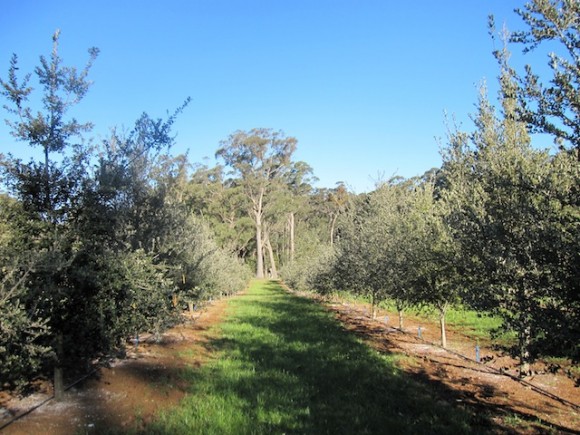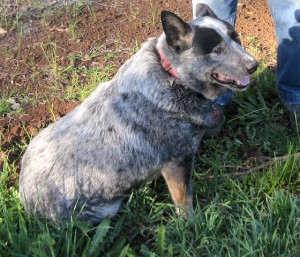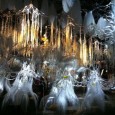It’s a cool spring day in Robertson, in the Southern Highlands of New South Wales. As I walk along the rows of trees, even though the sun is shining I’m glad to be wearing extra layers. My friend Jet, the Blue Heeler, is also having a great time scrounging around the tree roots. However, we’re not here just for the exercise and fresh air. We’re actually on the hunt for something surprisingly valuable.
I’m walking through a truffiere, or truffle farm, planted by retirees Ted and Barbara Smith who decided to enter the truffle industry eight years ago.
“I thought I’d like to do something that could be done with a small area, because even though we’ve got 75 acres I’m not a farmer, I’m a city slicker,” said Mr Smith. “But I thought it would be nice to get into something concentrated, with the prospect of a reasonable return but knowing that it’s basically a hobby interest.”
It took them five years for their first truffle to appear. But their hobby interest suddenly became a much bigger deal when earlier this year they discovered the largest truffle ever grown in Australia.
“It took me 30 minutes to get it out of the ground because I didn’t realise how big it was,” explains Mr Smith. “I started excavating around it; you’ve got to be so careful because you can break pieces off. But it takes patience and you do get impatient – you want to get this thing out of the ground.
“Got back to the house, washed the dirt off, and I could see it was in perfect condition. Then it went way off our scales. Our scales only went to half a kilo. So I went to the local post office. It was 1.172 kilos. I was absolutely astounded. I checked with the Truffle Growers Association and they verified that they didn’t know of any others that had been produced anywhere near that size so we knew we had the Australian record.”
Whenever I’ve thought of truffles, my mind has always turned to some Parisian restaurant– an accent to a three-course meal being consumed by some European aristocrats on the banks of the Seine. Of course this image hides the truffle’s more humble beginnings. It is, after all, nothing more than a fungus slowly growing from some spores on the roots of a tree until it is disturbed by an enthusiastic hog or dog. What has been known as a rare delicacy in Europe since ancient times is now one of the world’s ultimate culinary luxuries, with growers chasing prices of more than $2000 a kilo.
Australian farmers tried to enter the industry over 20 years ago, with the first attempts made in northern Tasmania in 1993. Six years later, the first ever Australian truffle was discovered at Deloraine. By 2010, an estimated 600 hectares of land were under cultivation right across Australia.
But not everyone who has entered the industry has enjoyed success. Truffles are notoriously difficult to cultivate. Growers must exactly replicate European growing conditions to have a chance – for example, the Smiths added 50 tons of lime per hectare when preparing their truffiere to change the pH of their soil.
“The way you’ve got to look at truffles is if you’re looking for a guaranteed return – don’t do it,” says Ted Smith. “Or if you’ve got to borrow money to do it – don’t do it.
“The majority of growers are not producing. I know that sounds funny but the growers are growing trees. The number that are actually producing truffles is relatively small, something like 10 per cent. I know people who have had trees for 12 years but haven’t had any truffles. For some reason we’re doing something right; conditions are right. Robertson just seems to fit the parameters. Cold winters, frosts, good rainfall, good rich soil, all these things fit.”
But the uncooperative nature of the truffle is not dissuading people from entering the industry. From their beginnings in Tasmania, truffieres can be found in every state of Australia, with some of the largest operations in south-western Western Australia. The massive increase in supply has not gone unnoticed, with the price for truffles falling by almost a third in the past decade.
Growers are optimistic that the growth in supply can be met with new markets, both overseas and in Australia. Being a winter crop, growers in Australia can export their truffles to northern hemisphere consumers during their summer when demand is much higher. Australian truffle producers can now have their product shipped to Europe within 48 hours. Feedback from consumers has been positive, praising Australian truffles for their quality and similarity to the European original.
However, increasing Australian demand is also a priority. The Smiths are doing their part, holding truffle hunts throughout the winter to allow locals to experience what I did and be educated about truffles.
“We have groups of people from the Illawarra, Sydney, Canberra and the Highlands come on truffle hunts,” explains Mr Smith. “This year we had over 300 people. We greet them with a nice roaring open fire, they get hot drinks, we give them a lecture on truffles and then a demonstration with our dog ferreting out truffles. We have truffle treats, so visitors can smell, taste and buy fresh truffles. We’ve been inundated and the feedback has been phenomenal.”
But the vagaries of prices and ‘supply and demand’ have never been Ted Smith’s priority.
“We’re in a prestige sort of business but there are a lot of unknowns and no assurances or guarantees that you’re going to be successful. There’s a whole aura of mystique, romance and mystery associated with this whole business, and that was one of the attractions.”







